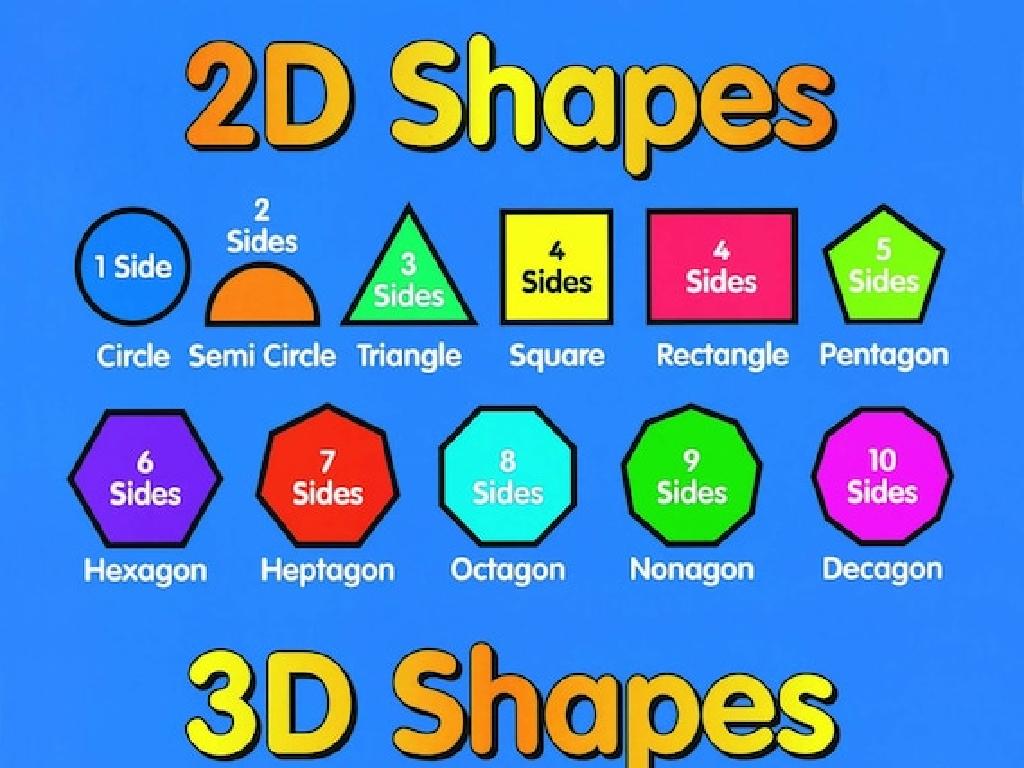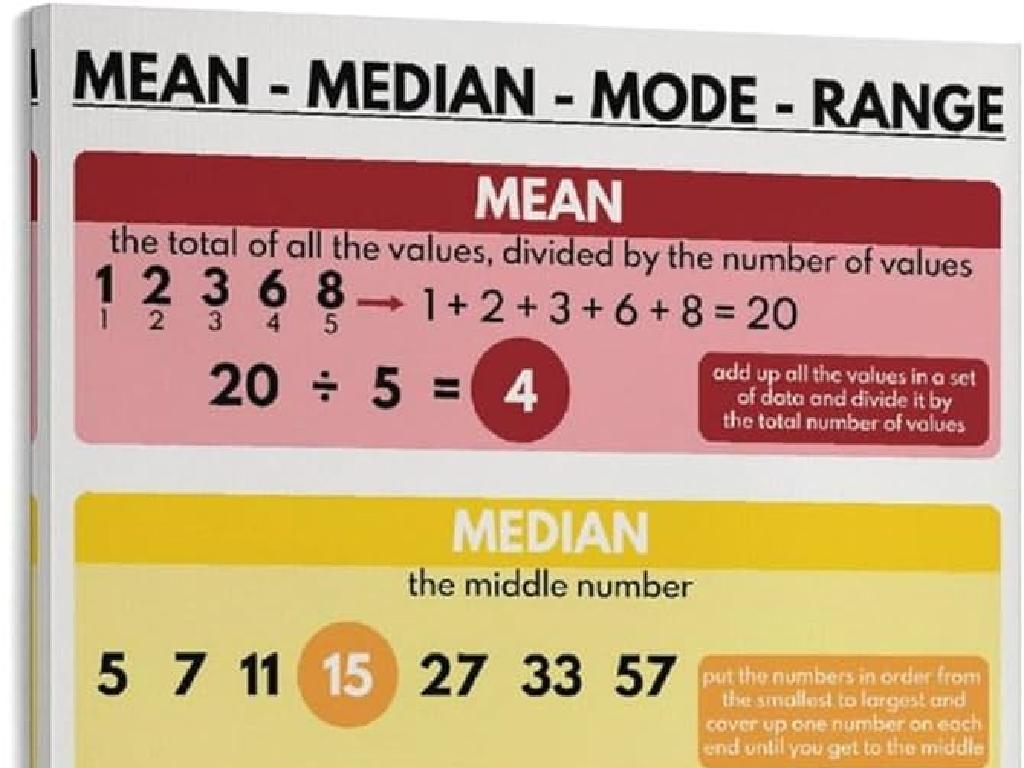Graph A Line From An Equation In Point-Slope Form
Subject: Math
Grade: Eighth grade
Topic: Linear Equations
Please LOG IN to download the presentation. Access is available to registered users only.
View More Content
Graphing Lines: Point-Slope Form
– Understanding algebraic language
– Introduction to linear equations
– Point-slope form equation
– Equation format: y – y1 = m(x – x1)
– Graphing from point-slope form
– Plot point (x1, y1), use slope m to find next points
|
This slide introduces students to the concept of graphing a line using the point-slope form of a linear equation. Begin by discussing the language of algebra and how it is used to express mathematical relationships. Introduce linear equations as equations that make straight lines when graphed. Focus on the point-slope form, which is particularly useful when a point on the line and the slope are known. Explain the components of the point-slope equation, y – y1 = m(x – x1), where (x1, y1) is a point on the line and m is the slope. Demonstrate how to graph a line by first plotting the known point and then using the slope to find other points. Provide examples and encourage students to practice with different equations to solidify their understanding.
Graphing Lines Using Point-Slope Form
– Define Point-Slope Form
– Equation: y – y1 = m(x – x1)
– m represents the slope, (x1, y1) is a point on the line
– Identify slope and point on the line
– Slope (m) is the steepness, (x1, y1) is where the line crosses a known point
– Utility of Point-Slope Form
– Allows easy plotting and understanding line direction
|
Introduce the concept of Point-Slope Form as a method to graph linear equations. Explain the equation y – y1 = m(x – x1), where ‘m’ is the slope and (x1, y1) represents a specific point on the line. Emphasize the importance of identifying these components to graph the line accurately. Discuss why Point-Slope Form is particularly useful: it provides a straightforward way to graph a line when a point on the line and the slope are known, and it helps in understanding the direction and steepness of the line. Encourage students to practice by picking different points and slopes to see how the line changes on the graph.
Graphing Lines: Point-Slope Form
– Find slope from equation
– Slope (m) is the coefficient of x in y – y1 = m(x – x1)
– Choose a line point
– Select any point (x1, y1) that the line passes through
– Practice with equations
– Given equations, identify m and a point on the line
– Graphing the line
|
This slide aims to teach students how to graph a line using the point-slope form of a linear equation. Start by explaining how to extract the slope (m) from an equation in the form y – y1 = m(x – x1). Emphasize that any point on the line can be used as (x1, y1) in the equation. Provide practice by giving students different equations and asking them to identify the slope and a point through which the line passes. Finally, demonstrate how to use these two pieces of information to graph the line on a coordinate plane. Encourage students to practice this skill with a variety of equations to build confidence and proficiency.
Graphing a Line Using Point-Slope Form
– Plot the given point
– Start with the point given in the equation
– Use the slope to find a second point
– Rise over run from the first point to determine the next
– Draw the line through both points
– Connect the points with a straight edge for accuracy
– Check the line with more points
– Plot additional points to ensure the line is correct
|
This slide is aimed at teaching students the step-by-step process of graphing a line from an equation in point-slope form. Begin by plotting the point provided by the equation on the graph. Next, use the slope, which is the ‘rise over run,’ to determine the position of a second point. Once two points are established, use a ruler or a straight edge to draw the line through these points, extending it across the graph. Encourage students to plot more points using the slope to verify the accuracy of the line. This exercise will reinforce their understanding of how a line’s slope and a single point can determine its entire graph. Provide examples and possibly a class activity where students can practice this method.
Graphing Lines from Point-Slope Form
– Graph y – 2 = 3(x + 1)
– Start at point (1, 2) and use slope 3/1
– Graph y + 4 = -1/2(x – 3)
– Begin at point (3, -4) with slope -1/2
– Discuss each graphing step
– Analyze the resulting lines
– Observe how slope affects line direction
|
This slide is an interactive class activity where students will graph two equations in point-slope form. Begin by plotting the point given in each equation on the graph. Then, use the slope to determine the direction and steepness of the line. For the first example, start at point (-1, 2) and move up 3 units and right 1 unit to plot the next point. For the second example, start at point (3, -4) and move down 1 unit and right 2 units for the next point. Discuss the steps taken to graph each line and how the slope and starting point determine the line’s appearance. Encourage students to notice the differences in the lines’ directions and steepness based on the slope values. This will help them understand the concept of slope and how it relates to the graph of a linear equation.
Class Activity: Graphing Point-Slope Equations
– Receive specific point-slope equations
– Graph each equation on coordinate plane
– Plot the point, then use slope to find next points
– Discuss solutions with classmates
– Share strategies and compare graphs
– Solve graphing challenges together
– Collaborate to overcome tricky equations
|
This activity is designed to reinforce students’ understanding of graphing lines from point-slope form equations. Distribute different equations to each student or pair of students. Encourage them to plot the given point on graph paper, then use the slope to find additional points and draw the line. Facilitate peer discussion to allow students to share their graphing strategies and solutions. This collaborative approach not only helps students learn from each other but also promotes problem-solving skills. Possible variations of the activity could include graphing equations with fractional slopes, negative slopes, or using an online graphing tool for a tech-integrated approach.
Class Activity Debrief: Point-Slope Graphing
– Students present their graphed lines
– Discuss any challenges faced
– Were there any common difficulties?
– Share insights from the activity
– What did we learn about point-slope form?
– Engage in a Q&A session
– Address any misunderstandings
|
This slide is meant to wrap up the class activity where students graphed lines from equations in point-slope form. Each student will have the opportunity to present their work to the class, fostering a collaborative learning environment. During the discussion, encourage students to talk about any difficulties they encountered and how they overcame them. This is a chance for the class to share their insights and reinforce their understanding of the concept. The Q&A session is crucial for addressing any lingering doubts and ensuring that all students are on the same page. As a teacher, be prepared with additional examples or strategies to help clarify any complex points. Possible activities could include peer review of graphs, group troubleshooting of common issues, or a mini-quiz to assess understanding.
Real-World Applications of Point-Slope Form
– Point-slope in daily life
– Used to calculate slopes in roads or ramps
– Science and engineering uses
– Predicts forces, velocities in physics
– Economic models and trends
– Analyzes financial growth, cost predictions
– Significance of linear equations
|
This slide aims to show students the practical applications of point-slope form in various fields. In everyday life, it’s used to calculate the incline of roads, ramps, and even roofs. In science and engineering, point-slope equations are vital for predicting physical forces, velocities, and trajectories. Economists use linear equations to model financial growth, market trends, and cost predictions. Understanding the importance of linear equations in these contexts will help students appreciate the value of what they’re learning and see its relevance to real-world problems and industries. Encourage students to think of other areas where they might apply linear equations.
Homework and Preview of Next Lesson
– Practice graphing point-slope equations
– Next lesson: Slope-Intercept Form
– Transition from point-slope to slope-intercept
– Explore real-world graph examples
– How do linear equations model real-life situations?
– Homework reinforces today’s lesson
|
For homework, students should complete the set of practice problems provided, focusing on graphing lines from equations in point-slope form. This will solidify their understanding from today’s lesson and prepare them for the next topic. In the upcoming class, we will explore the slope-intercept form of linear equations, which is another crucial concept in understanding linear relationships. Encourage students to think about how linear equations apply to real-world scenarios, such as calculating the trajectory of a ball or budgeting expenses over time. This practical application will help them grasp the relevance of the math they are learning. Provide examples and encourage students to bring any questions or real-world connections they have discovered to the next class.






